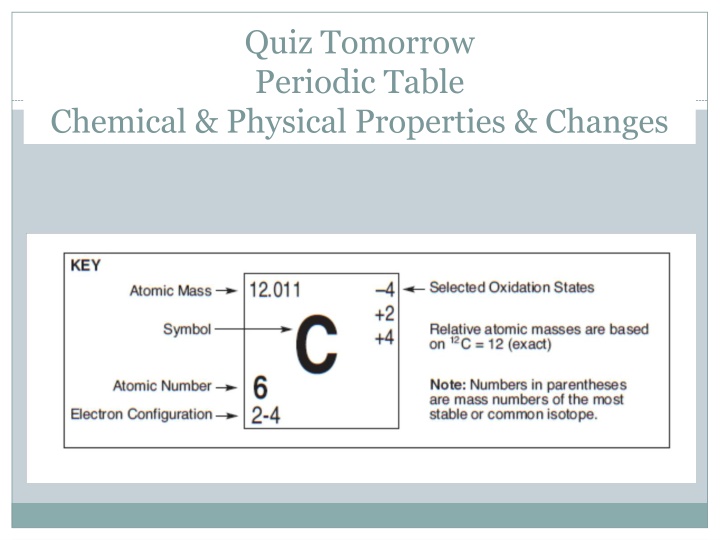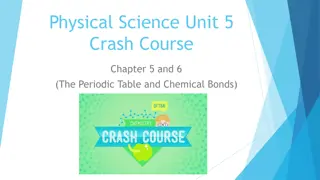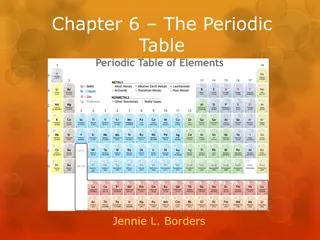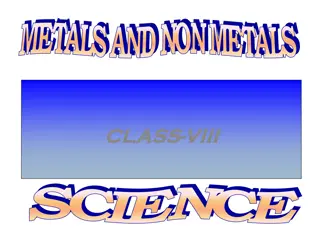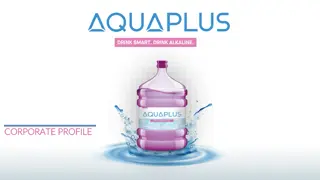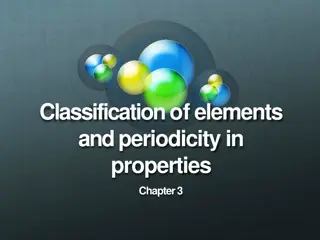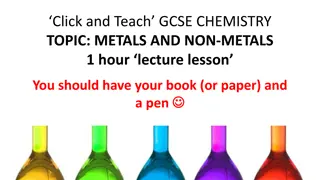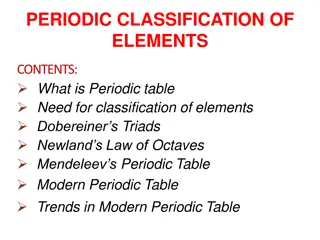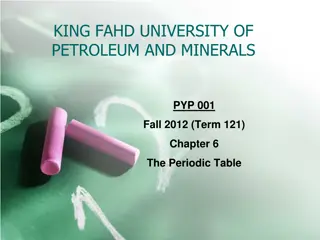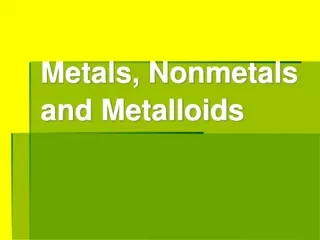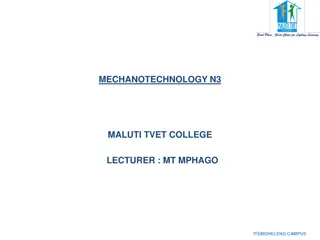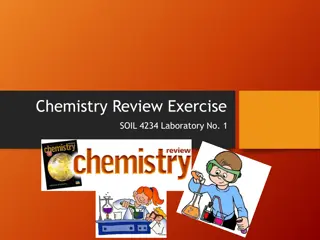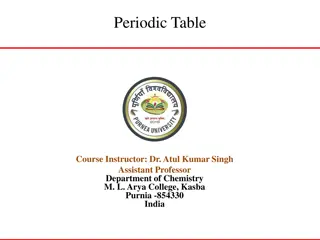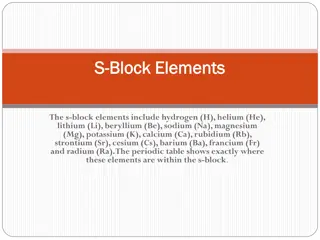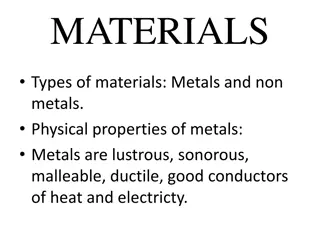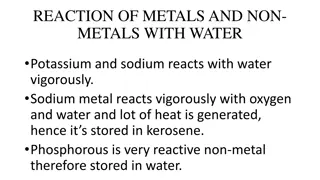Alkali and Alkaline Earth Metals in the Periodic Table
Explore the unique characteristics and behaviors of alkali and alkaline earth metals in the periodic table. Learn about the reactivity, storage, manufacturing, and general properties of these essential elements. Dive into the world of Group 1 and Group 2 elements to understand their role in chemical reactions and the physical properties that make them stand out. Discover the fascinating world of metal chemistry with this comprehensive overview.
Download Presentation

Please find below an Image/Link to download the presentation.
The content on the website is provided AS IS for your information and personal use only. It may not be sold, licensed, or shared on other websites without obtaining consent from the author.If you encounter any issues during the download, it is possible that the publisher has removed the file from their server.
You are allowed to download the files provided on this website for personal or commercial use, subject to the condition that they are used lawfully. All files are the property of their respective owners.
The content on the website is provided AS IS for your information and personal use only. It may not be sold, licensed, or shared on other websites without obtaining consent from the author.
E N D
Presentation Transcript
Quiz Tomorrow Periodic Table Chemical & Physical Properties & Changes
More Details on Metals and Nonmetals and Periodic Table CHALK AND TALK LECTURE. YOU DO NOT NEED TO TAKE NOTES ON THIS, BUT THESE ARE AVAILABLE ON MY WEBSITE.
Part I s block, Groups 1 & 2 ACTIVE METALS
Alkali Metals Group 1 elements 1 valence electron (half filled S sublevel) most reactive metals. are not found uncombined in nature (elemental) are found as salts that are very soluble in water react with water to make Hydrogen gas and a solution of the alkali metal hydroxide. (strong bases) 2Na(s) + 2H2O(l) 2NaOH(aq) + H2(g) alkaline solutionsare basic solutions pH 7.1-14.0
Storage of Alkali Metals react with water so rapidly and exothermically (gives off lots of energy) that the Hydrogen often burns as it is produced. are usually stored under oil or kerosene to keep them from reacting with the oxygen or water in the air.
Alkali Metal Manufacturing Sodium is the only one manufactured on a large scale. To produce the free metal, sodium ions must be forced to gain electrons (reduction). The electrolysis (add electricity to break down) of molten sodium chloride makes elemental sodium. Also produced is Chlorine gas - another useful chemical
General Characteristics of Alkali Metals low density high conductivity low melting points soft consistency shiny when freshly cut
Alkaline Earth Metals Group 2 elements They have 2 valence electrons (completed S sublevel) Group 2 are less reactive than Group 1. (but still found only as compounds in nature) do not need to be stored in oil react with water to produce basic, (alkaline) solutions. (pH 7.1 14.0) Solid Calcium reacts with water to produce H2(g) slowly salts are less soluble than salts from group 1. Sea water has an abundant amount of magnesium and calcium ions. (2 most commercially useful from Group 2)
Alkali Earth Metal Manufacturing Lime is Calcium Oxide (CaO) Slaked Lime is Calcium Hydroxide (Ca(OH)2) Both are in important to industry
Part II p block Groups 13 - 18 METALS AND NONMETALS
Aluminum and Group 13 Boron is a metalloid (Semiconductor), common in minerals Used to make glass and water softeners Aluminium is so useful it was once as expensive as silver Most common metal in Earth s crust. Gallium is often used in thermometers instead of mercury. Indium and Thallium are rare.
Carbon and Group 14 Carbon is the building block of all life on Earth Silicon is an important metalloid Germanium is also a metalloid Tin and lead are very metallic
Nitrogen and Group 15 Nitrogen is a diatomic and makes up 78% of the atmosphere The nitrogen in the atmosphere is very stable and cannot be used directly by living things Very important in fertilizer Phosphorous is also an important fertilizer. Elemental phosphorous glows. Arsenic and antimony are metalloids and poisonous Bismuth is a metal, salts of which are used in antacids.
Oxygen and Group 16 Oxygen is diatomic and the second most electronegative element Sulfur is a yellow solid that can be stable in its elemental state Selenium is a micronutrient meaning it s important for health but you don t need much of it. Tellurium and Polonium are uncommon
The Halogens ALL are highly reactive, Fluorine and Chlorine are diatomic gases but still extremely reactive. Fluorine is the most electronegative element, Chlorine is 3rd. Bromine is a diatomic liquid, found in seltzer Iodine is a diatomic solid that sublimes at room temperature.
Part III d and f block Groups 3 - 12 d block f block
Transition Metals are d block Can form multiple positive ions with different charges. e.g. Iron will for either a Fe2+ or Fe3+ ion Tin will form either a Sn2+ or Sn4+ ion When we get to stock naming system, the Roman Numeral tells you the charge on the metal ion. e.g. iron (II) oxide is Fe2+; Iron (III) oxide uses Fe3+
f block Rare Earth Metals Not truly rare but their properties are so similar they are hard to isolate from each other. Every element more massive than Uranium (92) is human created.
The Diatomics They are elements that are found as two atoms bonded to themselves. They are H2, N2, O2, F2, Cl2, Br2, I2 There are 7 of them and they are located here: Mr Race s Mnemonic Device: HOFBrINCl Hoff Brinkle
